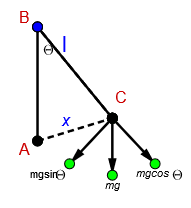Question
Question: The relation between T and g is given by \(\begin{aligned} & \text{A}\text{.}T\propto g \\\ ...
The relation between T and g is given by
A.T∝gB.T∝g2C.T2∝gD.T∝gl
Solution
In the question we are asked to find the relation between ‘T’ and ‘g’. Consider a mass “m” suspended on a wire of length ‘l ’ undergoes simple harmonic motion, ‘T’ is the time period, the time required to complete one oscillation and ‘g’ is the acceleration due to gravity (9.8m/s). To solve this we know the equation of time period; by squaring the known equation we can formulate the relation between ‘T’ and ‘g’.
Formula used:
T=2πgl
Time period of a simple oscillation is given by
Complete answer:
To find the relation between ‘T’ and ‘g’,
Let us consider ‘l ’ to be the length of the pendulum.
As we know, time period is given by the equation
T=2πgl
Squaring both sides of the equation, we get
T2=4π2gl
From this equation we get,
T2∝gl
Thus we can conclude that, T∝gl, when l is unchanged.
So, the correct answer is “Option D”.
Additional Information:
Time of a simple pendulum derivation:

Consider a simple pendulum with a mass ‘m’ suspended on a wire of length ‘l ’.
For one oscillation the pendulum is displaced at an angle of ‘θ’ by ‘x’ distance.
Let T0 be the time period at equilibrium.
T0=mg
When the pendulum oscillates, it is displaced at a small angle θ
For this small displacement θ, the restoring force acting will be
Restoring force=−mgsinθ
Since the angle of displacement θ is very small here, we can approximate sinθ to θ
I.e. sinθ≈θ
Hence the force here can be rewritten as
F=−mgθ
Now let us consider the triangle ABC in the figure.
We know that sin of the angle θ is the ratio of the opposite side to the hypotenuse of the triangle. Since here sinθ≈θ, we can write this as
θ=hypotenuseopposite
Here the opposite side of the angle is the displacement ‘x’ and the hypotenuse of the triangle is length ‘l ’ of the pendulum. Hence we can rewrite the equation as
θ=lx
Therefore the restoring force on the pendulum is
F=−mgθ=−mg×lx
By Newton’s second law of motion, we have the equation of motion as
F=ma, Where ‘m’ is the mass of the body and ‘a’ is the acceleration.
We can rewrite this equation as
a=mF
From the previous equation, we know that F=−mglx. Substituting this here, we get
a=m−mg(lx)
Eliminating the common terms, we get
a=−lg×x
For a simple harmonic motion we know that, a=−ω2x
On comparing both these equations, we get
−ω2x=−lgx
By simplifying this,
ω2=lg
ω=lg
Time period ‘T’ is given by the equation
T=ω2π
Substitute the value of ω in this equation
Therefore time period, T=2πgl
Note:
This question can be solved by another method.
We know that, for a simple pendulum its angular frequency ω is given by
ω=lg
Time period of an oscillation can also be written as
T=ω2π
By substituting the value of angular frequency (ω ) in the above equation, we get
T=2πgl
Thus we get T∝gl
Hence we get the same solution.
